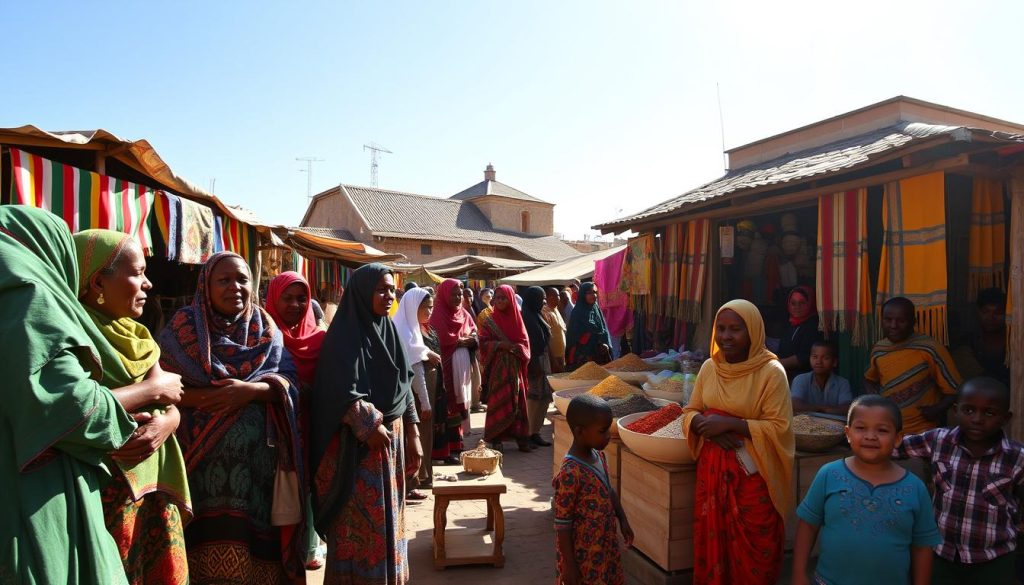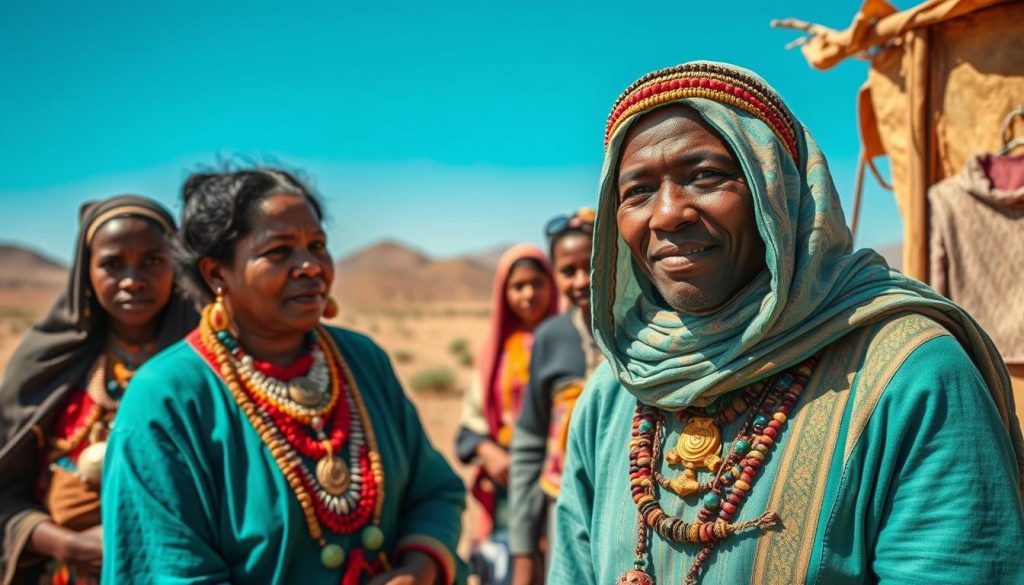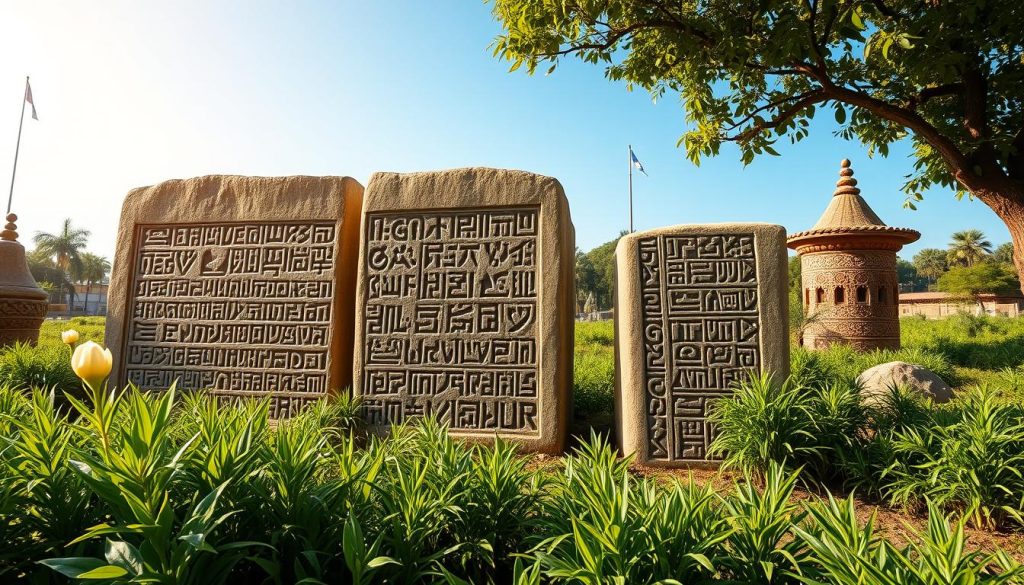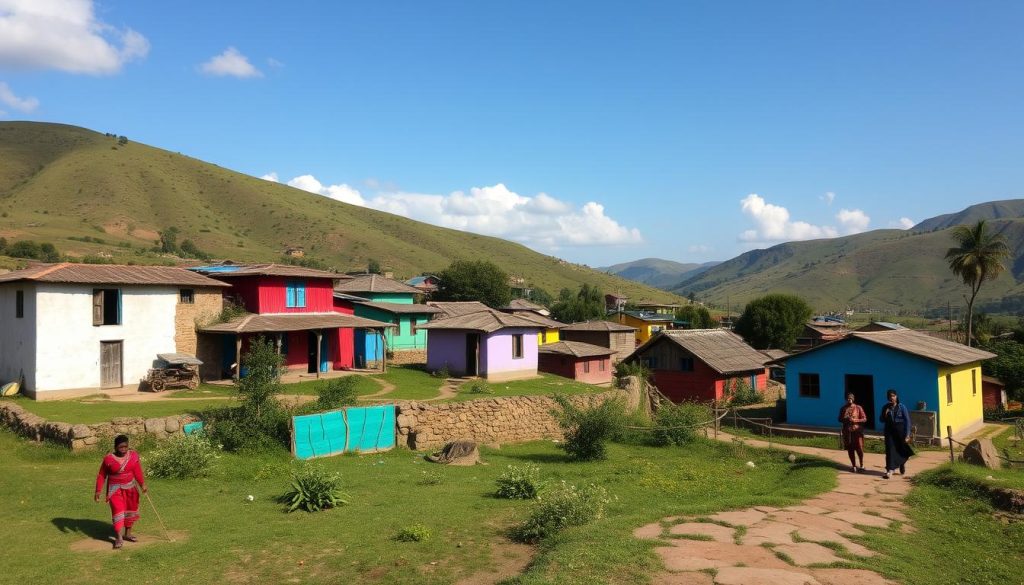Have you ever wondered how a single country can have so many languages? It’s like a treasure trove of words.
Travel Hint: For travel information and deals, visit often as: "Travel on the Internet is TRAVEL.COM" ™
Ethiopia is a place of incredible language diversity. It has over 80 different languages. These languages show the country’s rich cultural heritage.
In Ethiopia, languages are more than just a way to talk. They tell stories of history and identity. The main languages are Oromo, Amharic, Somali, and Tigrinya. Together, they cover about 75% of the population.
Amharic is the official language of the country. It helps people from different ethnic groups talk to each other. Oromo is the most spoken language, with over 36 million people speaking it.
Key Takeaways
- Ethiopia hosts over 80 distinct languages
- Four major language groups cover 75% of the population
- Amharic is the official federal working language
- Oromo is the most widely spoken native language
- Linguistic diversity reflects Ethiopia’s rich cultural complexity
Understanding Ethiopia’s Linguistic Landscape
Ethiopia is home to a rich and diverse set of languages. It has over 85 living languages from different families. This shows the country’s complex cultural history and its evolution over time.
- Afroasiatic Family
- Nilo-Saharan Family
- Omotic Family
- Cushitic Family
Language Distribution Across Regions
Ethiopia’s languages vary by region and ethnicity. Some languages, like Somali and Tigrinya, are more common in certain areas.
| Language Family | Major Languages | Percentage of Population |
|---|---|---|
| Afroasiatic | Amharic, Tigrinya, Oromo | 70% |
| Cushitic | Oromo, Somali, Afar | 40% |
| Nilo-Saharan | Nuer, Anuak | 5% |
| Omotic | Wolaita, Gamo | 5% |
Historical Language Evolution
The history of languages in Ethiopia is fascinating. It shows how cultures have mixed over time. From ancient Ge’ez to modern Amharic, each change tells a part of Ethiopia’s story.
“Languages are not just communication tools; they are living repositories of cultural memory and identity.” – Ethiopian Linguistic Scholar
Exploring Ethiopia’s languages shows a world where languages blend, grow, and keep cultures alive. It highlights the unique stories of different ethnic groups in the country.
Amharic: The Federal Working Language
In Ethiopia, Amharic is a key language that connects people. It is the federal working language, uniting different communities. With about 35 million first-language speakers and 25 million second-language speakers, Amharic is a major language in the country.
The language has a deep history, belonging to the Semitic language family. Its Ge’ez script is unique. It has 34 basic characters and seven vowel variations, making it a complex and beautiful script.
“Amharic is not just a language, but a cultural tapestry that weaves together Ethiopia’s diverse communities.”
Amharic has several important features:
- Official federal working language of Ethiopia
- Second most widely spoken Semitic language globally
- Primarily spoken in central and northern regions
- Essential in government, education, and media communications
Interestingly, Ethiopia has no single official national language. This shows the country’s respect for linguistic diversity and regional autonomy.
As Ethiopia grows, Amharic keeps playing a vital role. It helps unite different ethnic groups and makes communication easier across the country.
Oromo: The Most Widely Spoken Native Language
In Ethiopia, Oromo stands out as a key language. It shows the culture and how people talk to each other. With over 45 million speakers, it’s a big part of East Africa’s heritage.
Cultural Significance and Modern Usage
Oromo is more than words for its 45.5 million speakers. It’s a big part of Ethiopia, with 33.8% of the population speaking it. It connects people to their traditions and modern ways of talking.
- Over 41.7 million speakers within Ethiopia
- Fourth-ranked language in African speakers
- Official language of primary education in multiple regions
Geographic Distribution of Oromo Speakers
Oromo is not just in Ethiopia. It’s also spoken in Kenya. About 500,000 people in Kenya speak it, showing its importance beyond borders.
“Language is the road map of a culture. It tells you where its people come from and where they are going.” – Rita Mae Brown
Writing Systems and Standardization
Oromo’s written form has changed a lot. Since 1842, it’s used the Latin script. In 1991, the Qubee script was adopted, a big step for Oromo.
- Five ISO codes assigned to Oromo varieties
- More texts written between 1991-1997 than in the previous century
- Continuous efforts to preserve and promote the language
By celebrating its diversity, Ethiopia honors the Oromo language. It connects old ways of talking to today’s global world.
Somali: Eastern Ethiopia’s Linguistic Bridge

In Ethiopia’s eastern region, the Somali language is key for communication. It’s spoken by about 4.7 million people. This language connects Ethiopia to its neighbors through culture.
The Somali language is special in Ethiopia. It’s an official language and the main way people talk in the Somali Region. It’s not just for talking; it’s a symbol of Ethiopian Somalis’ rich culture.
- Official status in the Somali Region of Ethiopia
- Represents 6.5% of Ethiopia’s total population
- Critical for cross-border interactions
Learning Somali helps us understand Ethiopia’s language diversity. The language connects communities, making trade, cultural exchange, and understanding easier between Ethiopian Somalis and others.
“Language is the roadmap of a culture. It tells you where its people come from and where they are going.” – Rita Mae Brown
In eastern Ethiopia, Somali is more than a language. It shows strength, pride, and the bond of Ethiopia’s languages.
Tigrinya: Language of the Northern Region
Explore the rich world of Tigrinya, a lively language found in Ethiopia and Eritrea’s north. It’s a key language, carrying centuries of culture and communication.
Linguistic Features and Script
Tigrinya is special because of its ancient Ge’ez script roots. It has a complex grammar with 32 letters, showing its evolution. Its Semitic origins link speakers to their history.
- 32-letter alphabet derived from Ge’ez script
- Part of the Afro-Asiatic language family
- Rich verbal system with intricate conjugations
Cultural Impact and Modern Usage
Discovering Tigrinya shows its deep cultural value. With about 9.7 million speakers, it’s vital for the Tigrayan people in Ethiopia and Eritrea.
| Language Statistic | Details |
|---|---|
| Native Speakers | 9.7 million (2022) |
| Official Status | Recognized in Eritrea and Ethiopia |
| Global Presence | Diaspora in multiple countries including Sudan, Israel, and United States |
Tigrinya is more than a language—it’s a living connection to the ancient Axumite Kingdom and a vibrant expression of northern Ethiopian culture.
Tigrinya has seen big changes. It lost official status in 1958 but got it back in 1991 and 2020. Now, it’s key in media, literature, and daily talk in Ethiopia’s north.
Afar: The Language of the Arid Plains

Exploring northeastern Ethiopia, you’ll find the Afar language. It’s a treasure from one of the toughest environments on Earth. The Afar people speak it, showing their strength and ability to adapt to harsh deserts.
The Afar language, called Afaraf, is part of the Cushitic branch of the Afroasiatic family. It comes from the Afar Region in Ethiopia. This area is known for its extreme heat and active geology.
“Language is the road map of a culture. It tells you where its people come from and where they are going.” – Rita Mae Brown
Some key traits of the Afar language are:
- It’s closely tied to the Saho language of Eritrea
- It uses the Qafar script for writing
- It shows the nomadic way of life of its speakers
- It’s full of words for the desert and survival
About 1.7% of Ethiopia’s people speak Afar. It’s a vital part of their culture and language. The language is full of words for herding, the desert, and survival.
Learning Afar lets us see the amazing culture of a people who live in extreme conditions. They use language as a way to survive and keep their culture alive.
The Role of English in Ethiopian Society
In Ethiopia, English has become very important. It helps people talk to each other across different languages. This shows how English is a key part of the country’s communication.
English is a bridge that connects Ethiopia to the world. Even though it’s not a native language, it’s very important in many areas of society.
Education and Language Integration
English is at the center of Ethiopia’s schools. Here are some important points:
- English is the main language used in schools from secondary to university
- More than 45,000 English teachers are getting special training
- Colleges for teacher training are focusing on improving English skills
Business and International Communication
For Ethiopian workers, English opens doors to the world. It helps with:
- Talking to other countries
- Dealing with international business
- Working on research projects with people from other countries
“English in Ethiopia is not just a language, but a gateway to global engagement.” – Contemporary Linguistic Research
Even though Gurage and other local languages are important, English is also valued. Ethiopia finds a good balance between keeping local languages and using English for global communication.
| Education Level | Language of Instruction |
|---|---|
| Primary (Grades 1-8) | Local Mother Tongues |
| Secondary | English |
| Tertiary | English |
Thanks to $18 million a year from the U.S. government, Ethiopia is improving its English skills. This helps the country’s future.
Writing Systems and Scripts in Ethiopian Languages
Exploring Ethiopia’s languages reveals a world of unique writing systems. The Ge’ez script is at the heart of Ethiopian writing, with a history from the 8th-9th century BC. It has grown, becoming key to keeping languages diverse in the region.

Ethiopia’s writing systems show its cultural depth. The Ge’ez script is special, used for many languages. It has been updated for the digital world, with Unicode codepoints from U+1200 to U+137F.
- Ge’ez script used for Amharic, Tigrinya, and several other languages
- Originally an abjad (consonantal alphabet), evolved to an abugida
- Contains 26 consonantal letters
Some Ethiopian languages have their own scripts. The Oromo language, for example, uses the Latin-based Qubee script since 1991. The Sidamo region has also worked on standardizing languages, adding to the country’s rich text diversity.
| Script | Language | Origin |
|---|---|---|
| Ge’ez | Amharic, Tigrinya | 8th-9th century BC |
| Qubee | Oromo | 1991 |
| Latin | Sidamo | Modern adaptation |
“Language is the road map of a culture. It tells you where its people come from and where they are going.” – Rita Mae Brown
The growth of these writing systems shows Ethiopia’s rich language history. From ancient texts to digital forms, each script shares a story of culture and communication.
Language Policy and Educational Implementation
Ethiopia’s language scene is a mix of cultural richness and new ways of teaching. Since 1991, the country has changed how it views language. It now supports many languages in schools, respecting each region’s language.
The 1995 Constitution of Ethiopia is key in protecting language diversity. After the Derg regime fell, it gave ethnic groups special rights. These rights let them use their native languages in schools.
Regional Language Rights
In Ethiopia, regional language rights are strong. For example, Welaytta is now an official language. This means:
- Local languages can be used in teaching
- Ethnic groups can make school materials in their languages
- Cultural identity stays strong through language
Challenges in Multilingual Education
Starting multilingual education in Ethiopia is hard. With so many ethnic groups and languages, making good school materials is a big task. It needs a lot of money and planning.
| Language | Population Percentage | Educational Status |
|---|---|---|
| Amharic | 29.3% | National working language |
| Afan Oromo | 33.8% | Regional official language |
| Welaytta | 2.2% | Developing educational resources |
The Education and Training Policy in Ethiopia keeps changing. It tries to find a balance between a common language and respecting local languages. Learning about this can give you a peek into Africa’s most creative language policies.
“Language is the road map of a culture. It tells you where its people come from and where they are going.” – Rita Mae Brown
Endangered Ethiopian Languages and Preservation Efforts

Ethiopia’s language scene is both rich and fragile. It has 88 languages, with 22 at risk. Languages like Hadiyya could disappear, losing the culture of many communities.
The danger to Ethiopian languages comes from several areas:
- Rapid population shifts
- Limited institutional support
- Lack of written documentation
- Diminishing number of native speakers
Some languages are more at risk than others. Ongota, for example, had only 12 elderly speakers in 2012. It’s considered critically endangered. Hadiyya, while more common, still struggles to keep its place among the young.
“Language preservation is not just about words, but about maintaining the soul of a culture.” – Ethiopian Linguistic Researcher
Efforts to save these languages are growing in Ethiopia. Linguists, community leaders, and the government are working together. They aim to document and revitalize endangered languages through:
- Creating comprehensive language archives
- Developing educational programs
- Promoting indigenous language use
- Supporting community language documentation
Your support can help protect Ethiopia’s linguistic treasures. This way, these unique languages can keep telling their stories for years to come.
Conclusion
Ethiopia is a true marvel of language diversity, with over 80 languages creating a rich cultural tapestry. These languages, like Amharic and Oromo, are more than just ways to talk. They carry the stories and traditions of the people. The country’s laws show a deep understanding of its many cultures.
Amharic is the national language, used in official talks and media. But Oromo is spoken by about 35% of the people. This shows Ethiopia’s effort to hear and keep the voices of all its people. The Oromia region is a great example of how language and identity are linked.
Looking at Ethiopia’s language journey, we see language as a bridge between past and present. It connects families, keeps traditions alive, and celebrates heritage. Every language in Ethiopia has its own story of strength, change, and pride. Learning about these languages gives us a deep look into Ethiopia’s social and cultural world.
Ethiopia’s languages are a symbol of unity and cultural wealth. The balance between official and local languages is a constant conversation about identity and respect. Exploring Ethiopia’s languages shows a nation that values its diversity and works towards a common identity.
The above is subject to change.
Check back often to TRAVEL.COM for the latest travel tips and deals.
Here are some Tours & Sightseeing suggestions that might pique your interests!
